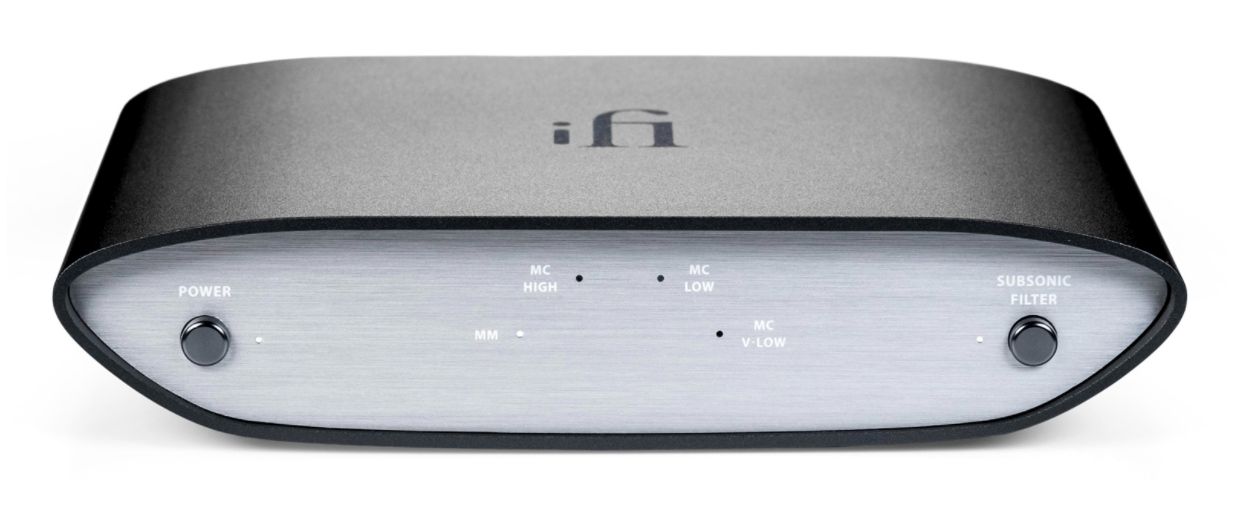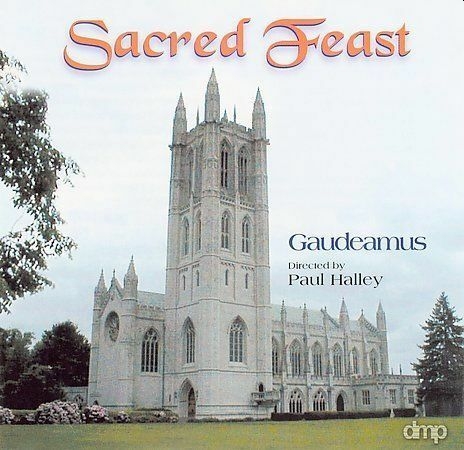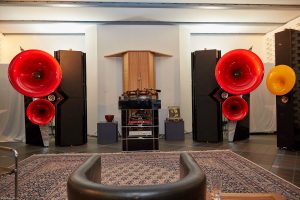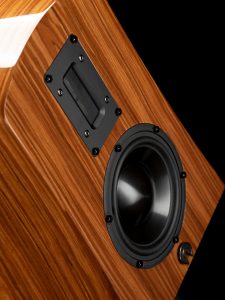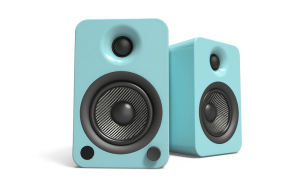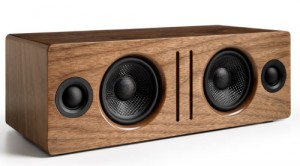for art's sake – the art of listening to music including hi-res audio, MQA, DSD and 5.1 surround sound

A recent product from Starke Sound in Gardena, California is called VLOT. I still don't know what the VLOT acronym is supposed to stand for. So I'll take a stab at it, ummm….Verisimilar Layered Orthogonal Trajectories (of sound)? Read more here to see what I mean. And I really did just come up with that but it touches on several things about VLOT I planned to write about anyway.

VLOT from Starke Sound - Limited Ebony acrylic enclosure, MSRP $1499/pair
No Sizzle, No Boom, No Problem
Despite the audio community's raccoon-like attraction to shiny sounds and notably some kick-butt boom in the bass and some laser like sizzle on the high and uber high end, I have settled back in my listening habits to try to find authentic sounds in whatever form they may have first appeared off an acoustic or electric instrument or from a singer or percussion section. The manufactured sizzle-and-boom compression common to consumer, and even prosumer gear is not my thing as it sounds and is by definition artificial. This distracts me from what is really being played.
Not only do I want to hear what it sounded like when acoustic sound waves hit a microphone, from even an electromagnetic humbucker signal off a Gibson SG through a Vox amp with a SM57 in front of it, I also like to hear in the recording playback exactly what those sounds became as reflections bouncing off studio or café/bar/public hall walls and ceilings and floors during the recording, as if I was in the audience catching a direct mix off the stage delivery as well as from the room itself.
Is that too much to ask? Not really. In many ways capturing the stage and room using minimal mics/tracks is a simpler recording approach than many more common approaches that require miles of aisles of gear stacked for compression, reverb, flange, de-flange, re-flange and maybe even some voice correction tweaks thrown in.
Lots of recordings have managed to sound natural from the earliest compositions I heard on Columbia and RCA vinyl recordings way back when (think blues, classical, musicals, early folk, and bluegrass). These are still easy to find in print which includes downloads and streaming. Hearing those lifelike reproductions of basically live performances mostly made in studios let me learn what all the instruments, percussion and singers really sounded like. I was young and hugely impressionable. It kind of stuck. Fortunately these types of recordings across all music genres are still created, albeit sometimes in hard to discover places as the music industry rolls on. For me this approach does not exclude electronica, particularly analog synth as well as more modern wave creation methods. What I want is original sound recreated as original through an honest playback system.
I unboxed and set up VLOT in a total of about 6 or 8 minutes out of the box and was playing MP3-320 streaming from the Spotify internet to my iPhone SE and as AAC into the VLOT Bluetooth antenna in the rear of the left speaker. The first thing I remarked to myself about VLOT was that they had no artificial boom or sizzle. Awesome!
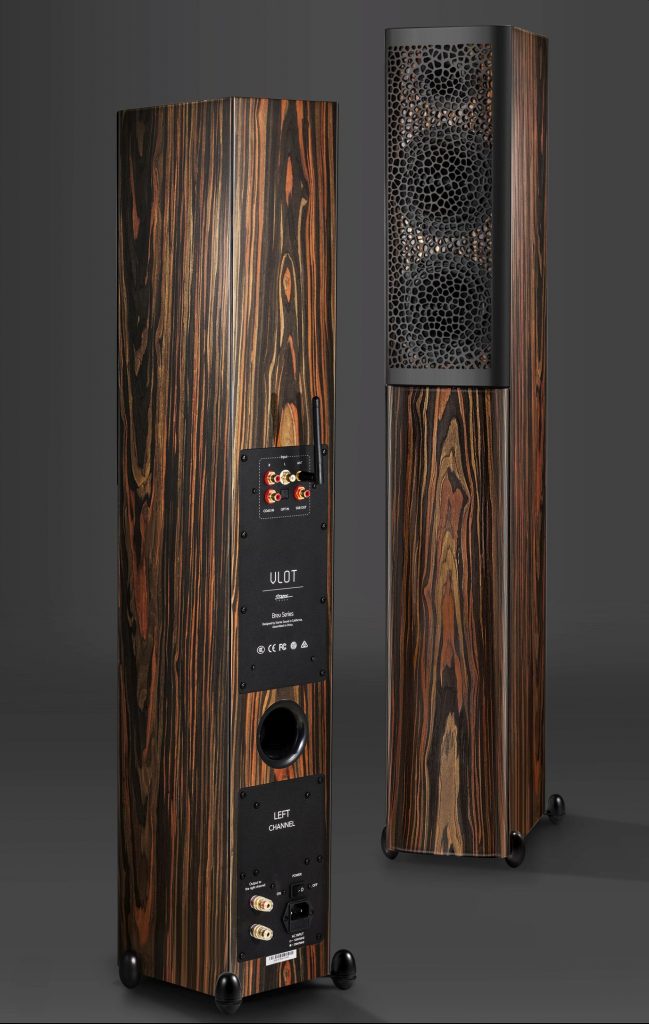
Starke Sound stock photo of VLOT Limited (Ebony) finish
A Happy Middle
Well, in transparent honesty, my very first reaction to the VLOT sound wasn't exactly "Awesome." Because what I first heard sounded grounded in the mid range sonically and spatially. That is, the 3 foot high speakers seemed to contain most of the sound somewhere around the 1.5 to 2 foot vertical layer in the sound stage. It didn't wow me. I'm sensitive to what I might call mid-range indulgence in speakers, and feel that emphasis there usually deadens the dynamics otherwise present. The KEF LS50 wireless speakers duly unimpressed me in this regard when I heard them a couple years ago.
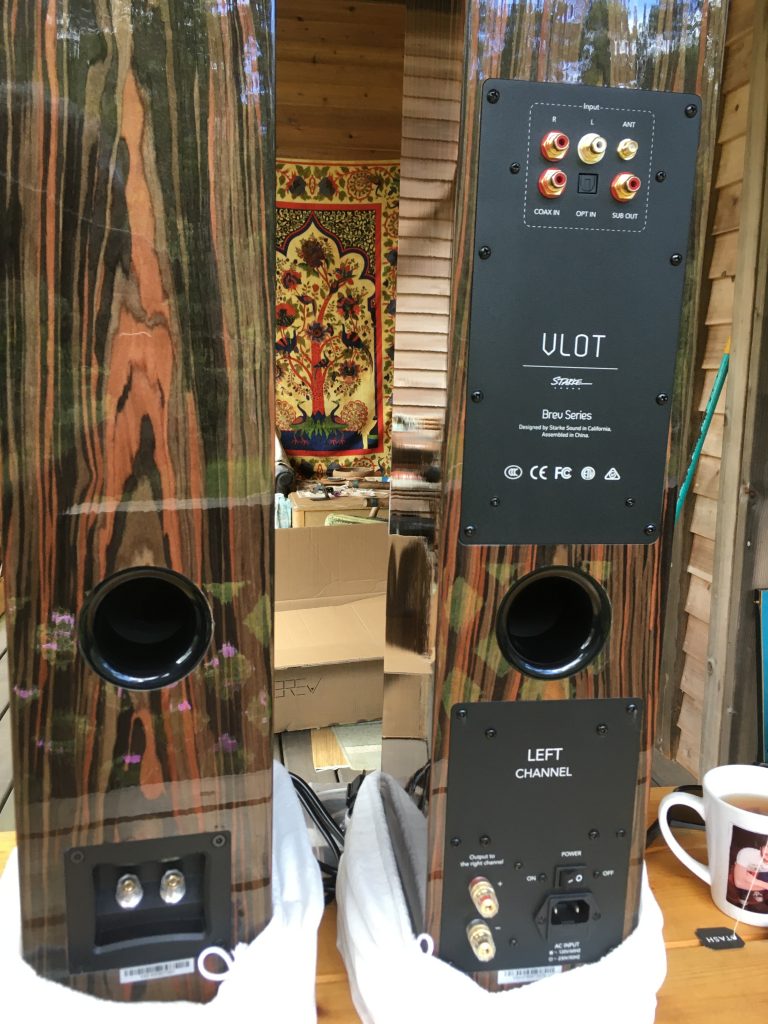
VLOT powered speakers (Ebony), 3 feet tall, 150W RMS (4 ohm), Max SPL 108dB, 45 Hz – 25kHz, Bluetooth 5.0 (antenna not attached), Optical, Coax, AUX RCA inputs, 1 x 1" Tweeter, 2 x 4" Mid-Bass Drivers
As you might see in the photo above, I had unboxed and set the VLOTs on a picnic table on my lanai to get a good look at them. I first plugged them in then and there. So my first sonic experience with VLOT was one with no solid floor beneath them and an unusually high position for the speakers (about 29" off the floor, then another 21" to the bottom of the cabinet to the lowest speaker driver). The sound was a bit flat and thin or muted. No surprise, right? But what did I know? They could have sounded fantastic, and I had wanted to easily see what I was looking at on the patch connect panels. So I'd left the VLOTs on the table and plugged them in and turned them on. I would soon correct my silly ways.
At the same time that I was glancing at the eight-page User Guide that came with the package I was scanning the rear speaker panels looking for the magical Power On icon. It was nowhere to be found. I spent an elevated 15 or 20 seconds of my 6 – 8 minute setup wondering where the mystery controls were when there should have been no mystery. I had already turned the main power switch on (lower right on photo above). What I couldn't find was the touch control panel to take the unit out of sleep mode, select proper input and adjust volume. I had gotten nowhere very fast. I kept looking for the panel described in the User Guide but didn't see it.
Then I discovered that in my all too convenient approach to examining the goods standing up, I'd neglected to look at the top of the left speaker (which on the picnic table was above my head) where the touch control panel is a smooth inset. What did I know? Once located, I held the Power On button (really a Sleep/Awake button) down for 3 seconds and the panel lit up with a color indicating the input mode (Blue = Bluetooth!). The "F" button changes the function for the other inputs supported (Coax (green), Optical (red), AUX/Analog RCA (white)). That's it other than V+ and V- for you can easily guess what. Simple.
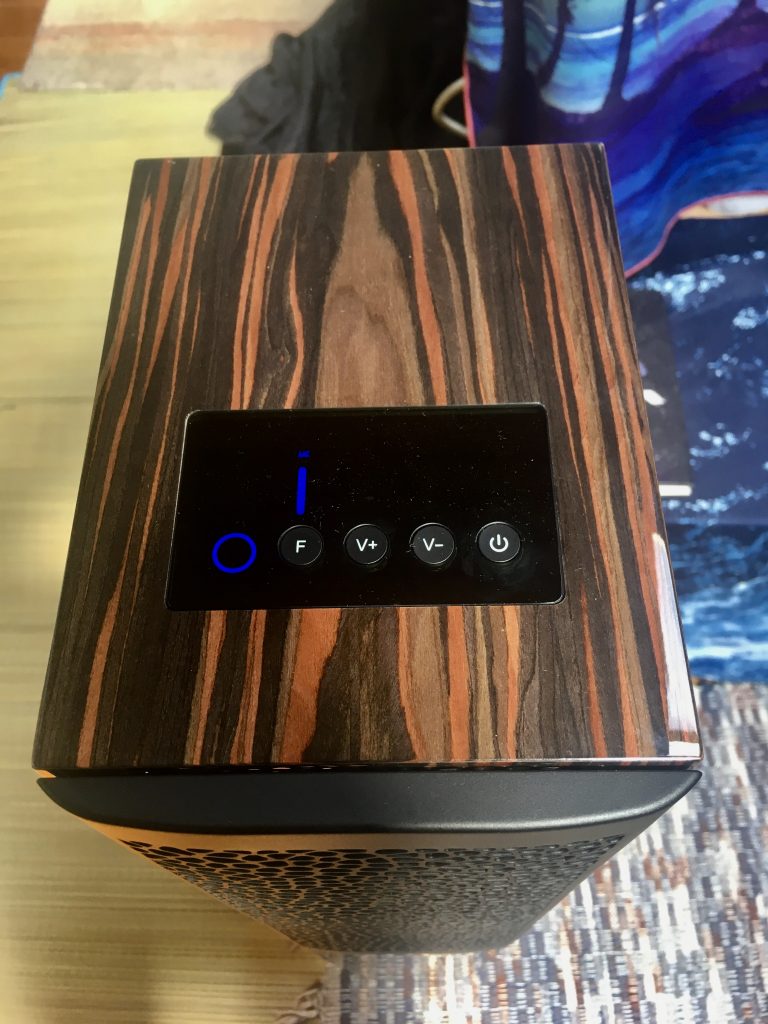
VLOT control panel inset Left speaker (Function, Volume+, Volume, Power/Sleep)
A Power Break
VLOT powers down to 3 watts when sleeping (2.8W on my Kill A Watt meter) and awakens at about 4.1W (equivalent to an LED light bulb replacing a 40W incandescent). To its immense credit the VLOT rarely used more than 9 watts (approximately same power used as an LED light bulb replacing a 60W incandescent bulb) during my lively playbacks of music via Bluetooth.
With the music levels at more or less full bore (plenty of bass and percussion bottom in plenty of songs), it barely registered above 15 watts or the same as a single LED bulb for 100W worth of lumens. There's no other powered gear involved (DAC, Preamp, separate amplifier, etc.). That is far less than half the power I'm used to consuming on a Stereo/Mch NAD Class A/B amplifier I've been driving lately. This accolade comes from me in a zero net carbon home driven by solar PV where every watt is measured and counts.
This low power consumption is significant and hugely impressive to me where at home I monitor every single electric consuming device in ongoing efforts to reduce daily and monthly power consumption. Do you know how many watts your refrigerator uses when it is running and how many minutes it is running on average every 24 hours and how many watt hours and what electricity cost that translates to each month? You might be shocked at the answers. Same questions apply for every other appliance, piece of audio gear and light fixture you operate.
If you don't know the answers to your power use let me suggest you buy the P3 International Kill A Watt power meter (P4400 model) and start measuring (List Price is $29.99). It is easier than easy to operate (just plug it into the outlet and plug your appliance or power strip into it) and can record use of any device or power strip of devices over time. The planet will really love you as will your checkbook as you will be paying better attention to the importance of both.
So in 6 minutes or so I had the Starke Bluetooth antenna connected, their AC cable plugged in, and the flat solid white speaker connector cable that Starke provided connecting the Left and Right speakers. In short, hookup was damn easy (see ERRATA below for the minor hiccups here).
The VLOT box that arrived weighed over 62 lbs. and was large and bulky to carry. But the speakers themselves are no worries to lift and move, separately of course. I've carried them one at a time with the speaker wire connected inside and outside my lanai door many times. Easy peasy. These are relocatable tower speakers with no amp or other wires for immediate Bluetooth use (supporting all lossless specs) use. Convenient, with some stellar sound. Read on.
Dial In Your Sound
About the same time I was discovering I probably wasn't getting the full audio spectrum and oomph from the VLOTs standing high up on my hand made tongue and groove pine picnic table, I also remembered to take a look at my audio quality settings on my iPhone's Spotify app. These settings (WiFi and Cellular) make a huge difference in sound quality ranging from somewhere around 24kbps (downright awful quality) to a respectable 320kbps (indiscernible to my ears from CD quality). Out here in the hinterland forested volcano fringes of cell and sometimes questionable satellite Internet networks, the Spotify app requires changes to its streaming bitrates on some irregular basis.
Fortunately I was in the motherlode of ISP service on this day so I changed my Spotify Audio Quality WiFi Streaming setting to "Very High" which is MP3-320. No, it's not lossless, but about 20 years ago I did endless sound tests for my own benefit and determination, pitting MP3-192 and below, MP3-256 and 320 all against lossless CD ripped WAV and FLAC files. I listened to all of them on very good gear including external speakers and headphones.
At MP3-256's bitrate and density ("lossyness"?) I could not differentiate the lossy format from CD, nor at 320kbps. I'm not comparing this sound quality with hi-res, DSD or MQA, just with a CD Red Book 16/44.1 master. Nothing since has changed my observations about this parity.
So with Bluetooth engaged as the speaker setup (showing AAC on the panel, is it a lossless connection as Bluetooth 5? I don't know) and Spotify delivering its very best quality to my iPhone via broadband and the VLOT speakers squarely on the solid 2 x 6 fir lanai floor boards I took another listen.
What I heard then was some of the best stereo imaging I can remember hearing in a very long time. A few days later, this is still giving me head-shaking affirmation. Let me try to describe what I mean.
When Stereo is Rectangular Which Sounds Square but is Actually Cool
Like all of us, there are a lot of listening miles logged between my ears, and different speakers or headphones pouring stereo sound into them over the years. One description of stereo imaging might be something like: "The mid-centered reproduced sound is created by mixing any given input track (one mic or line source) as equal strength signals for both the left and right channels which on playback the ear-brain then assimilates as sound emanating from exactly midpoint between the speakers (ie, the center)." Note that this centered image is no different than mono delivered equally to two speakers. This technique is often used in the studio mix where the source track is mirrored on a second track then each channel hard panned as 100% left and 100% right.
Panning a bit left or right during the mixing stages of a recording implies less signal on one channel or another (L or R) so the sound appears to come from somewhere closer to the left or right speaker. Or it could come bang on from either speaker's exact location if the hard pan is 100% extreme (i.e., no signal presented in the other channel, just pan the balance all the way right or left).
Placing sounds in the room (mostly to an imagined stage in front of the listener) is the art and skill of engineers who work with the sound and EQ levels in left and right channels to arrive at the right horizontal locality blend for a song or passage. Also created are vertically oriented peaks and valleys where say a drum's cymbals seem to come from above the stage or the kick drum or bass notes appear to be below the guitar or piano or singer's voice and translate literally to the floorboards.
The reason I describe this—not as an authority on studio techniques, though I've hacked my share since the mid-80s on mostly my own recordings—is because I am now convinced that what VLOT's architecture and engineering have succeeded in doing is to establish a sound topology between the 2 column speakers that is radically different from what I'm used to hearing.
The magic I heard from the first day and continue to hear, regardless of where I have moved the speakers (indoors just in front of a 48" LED screen or out on the lanai spaced approximately 7 feet apart, both locations having solid wood floors and ceiling with the same roof peak rising to 12 feet) was a very articulate and definitive rectangle of sound that stays interlaced between the columns.
This rectangular space has many dimensional attributes within its borders, being able to project sound forwards towards the listener (based on image panning and gain) as well as vertically separate an unnamable number of frequencies and textures as layers within the boundaries. Sound projects behind the speakers as well. So far I have not setup VLOT anywhere close to a back wall, and am not sure I would want to even try that. I'd rather maintain the shaped sound space these open room standing towers provide me. It's as if they need the room to breathe.
A Sound Container
The unusual behavior here is that regardless of where I place the speakers, with either a side wall to the left and right (indoors) or just to the left side (outdoors), I can stare at the outermost vertical edges of the 2 speakers and literally see where I hear the sound stopping at their borders. In other words, the rectangle defined by the speaker columns (left, right, top, bottom) is the literal boundary of sound. There is also a 3D projection towards the listener usually distinct for some of the most perfect stereo center sounds in the mix and likely based on gain and tone.
Very few locatable tones escape these boundaries. Writing more on that detail may be a deep subject to address another time but I can say here that it is unique and impressive to listen carefully to at any volume.
The rear sound baffle on each speaker delivers other air pressures I see/hear behind the rectangle's plane. The speakers, once I properly positioned them on the floor use the 2 x 4" "Mid-Bass" drivers per speaker in yet another head-shaking manner. This reminds me of my tried-and-truly-loved Bose 402 PA speakers, each small column hosting 4 x 4" drivers and nothing more. Since the early 90s my 8 ohm Bose 402's have performed very well in live acoustic solo/ensemble/band performances with no sub-woofer. But there is no comparison to the frequency range attained by VLOT (45Hz) versus these Bose (90Hz) where VLOT extends fully to the bottom with no distortion or seeming effort.
By the way, there is nothing but real air beneath my indoor subflooring or the spaced 2 x 6" fir boards outside on the cabin's post & pier construction. This common Hawaiian home design creates a sonic air chamber for my building that is anywhere from 4 to 6 feet deep measured from earth/lava to the subfloor above. This serves as a nice cushion for all music's lows and rock bottoms.
The VLOT spec claims a low frequency limit down to 45Hz. While there is a Sub Out available on the VLOT, I very much doubt I would want to use any sub in my environment to interfere with the clean solid warm and synchronized bass I get from the two columns alone as they hum through the wood floors and into the air cushion below serving as a large baffle itself.
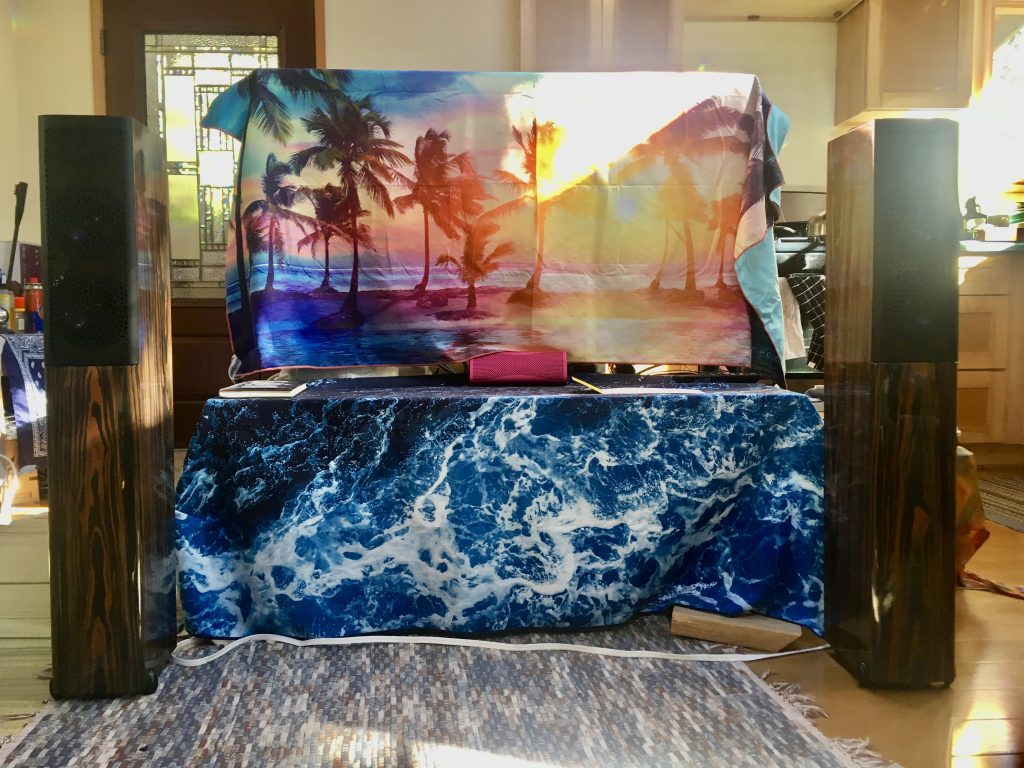
VLOT located in front of 48" entertainment LED TV to allow the rectangular sonic magic to occur. While most entertainment setups show speakers aligned with the LED monitor's plane, there are distinct and critical sound improvements made by placing the speakers some inches in front of the screen and table to allow proper stereo imaging. I found this to be especially true with VLOT.
Stereo to Beat the Band
Out of the box, I am quite possibly hearing better separation and focused yet warm playback (no Boom, no Sizzle) through VLOT than through my very well used and loved Monitor Audio Gold Series columns from 2002. I have not compared these 2 setups side by side, but am making an approximate mental comparison from memory. I never used a sub with the Monitor Audio setup (stereo or multichannel), and I would not add one here to the VLOT setup for reasons mentioned earlier. To boldly summarize, I have rarely if ever been so impressed with a fully-interlaced stereophonic image as with what I hear from VLOT. To be clear, I am not referring to the overall quality of sound reproduction in this comparison, only the stereo imaging.
I've positioned the VLOT speakers anywhere from 4.5 feet to a little over 7 feet apart. Starke Sound's document recommends keeping the distance to 10 feet or less. My sound playback rectangle always moves with the speaker locations, never busting out further to the left or right of the columns or even above or below as far as frequency is concerned. I hear and feel the sound from the rooms, boards, ceiling, walls but differentiate that added material as ambient and separate from the mix itself. They blend naturally but they are not one and the same.
This confined rectangular idea may sound less than ideal to you but let me tell you that it has grabbed my attention and provides a very real (Verisimilar), and Layered, rectangular (Orthogonal) 3D (mostly forwards but some oomph/grunt backwards) Trajectory to me regardless of how far I am away from the center point between the speakers. It then seems to redefine its perimeter as I move about the room. The VLOT delivery paints a real and believable performance-like soundstage.
I first placed my bent head slightly behind the center of both speakers at ear level to the middle (second) driver and heard the magic tapestry (rectangular shape) of sound slightly behind my listening point, which located it on the front facing plane between the speakers. I then stepped inches backwards directly into the plane between the speaker front panels and heard the vertical and horizontal space fill in around me then in front of me up very close. This is not a muddy fill-in by any means. It is layered. There are lots of different music styles I am working with here (read some of this list below), but a tangible separation of different instruments or at least frequencies and textures was obvious. There was nothing transient about it. It was squarely there. It also sounded like it was in perfect phase across the different drivers.
The more small steps I took backwards, keeping my head at the speaker driver level, the more distant the rectangle became, never losing its orthogonal sonic shape. A comfortable centered chair (outdoor) or platform foam (indoor) was home base for me to sit on and listen, with my back not far from a back wall. The speakers were located 12 feet away outside and 10 feet away inside. The walls are cedar siding outside and sheet rock with tapestry cover inside. The sound geometry that I could almost see outlined literally due to its clear positioning between the speakers got more intensely separated, layered and focused with the greater distances I listened from.
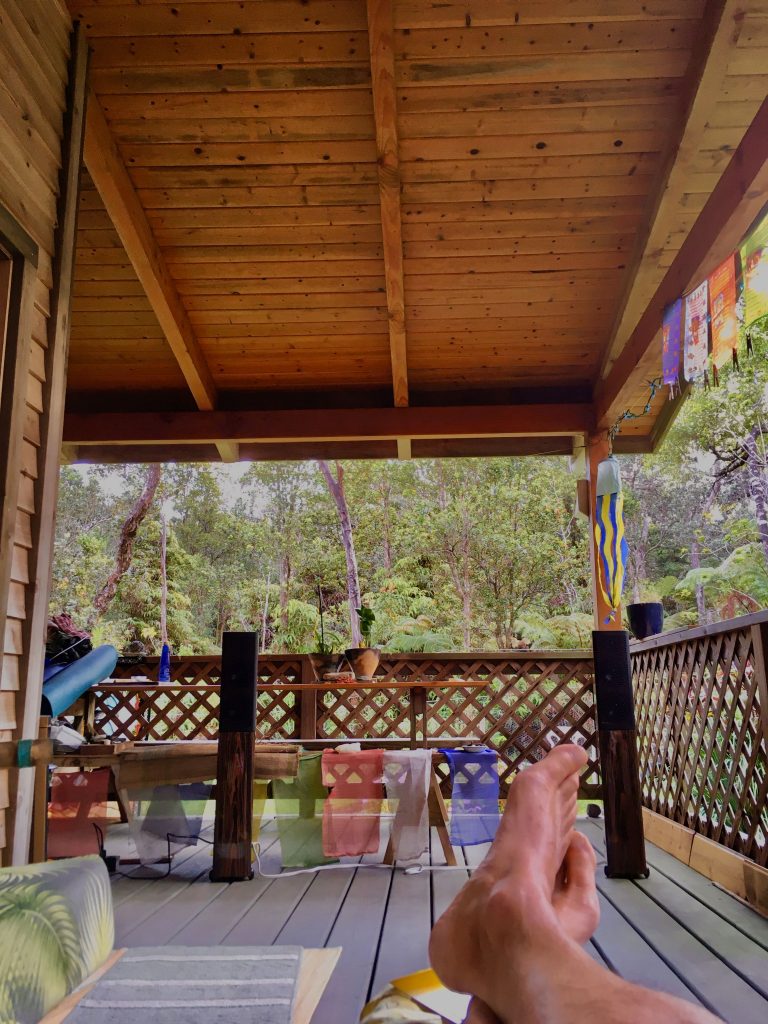
Even, or perhaps especially in the open space, VLOT sound does not get lost, but rather is focused in the rectangle defined by the columns left and right edges, top plane and floor. Presence is from that rectangular plane, with 3D projection towards the listener based on instrument/voice and panning in the mix.
I can't recall meeting this type of enjoyable boundary of sound being presented to my ears. One common listener inclination or expectation is to want wide sound arriving from everywhere in the room and filling the space, not as obvious echo reflections but as a full fabric. Not so with VLOT. It condenses its output and paints a wonderful picture for you in a 3D space not necessarily larger than today's typical LED TV. This makes me wonder if perhaps that was the intention of the designers and engineers all along.
Total Sound
I've yet to play a music style or recording I'm familiar with that doesn't come up sounding like roses through VLOT. This has ranged from solid pop to electronica with deep bass to traditional Irish fiddler and guitar, blues/swing/R&B, reggae, Nashville country, classical and rock/pop. Remember we are talking about a complete integrated stereo playback system here with 150 watts RMS per channel at 4 ohms. I've had VLOT's volume at maximum (it beeps at you when this ceiling is reached) and pushed the gain on the iPhone using Spotify's player with some louder than usual results. I don't often play anything too loud for many reasons. But when I put the pedal down on VLOT I got the business end of dynamic range. No breakage even with a lossy MP3 playing.
Added benefits of focused solid sound as delivered here include volume that does not need to be cranked to hear everything, including the space between sounds. Possibly the opposite is true (lower volumes deliver better-defined sounds) depending how much reflection exists in your listening space. Here's a catalog of some of the music I played with variations on dynamics leaning from favorites on sparse acoustic to the stomp and pop acoustic and electric boogie side: JJ Cale, Clapton and John Mayer, Andrée Burelli, Beck, Bach, Burning Spear, Melody Gardot, Leo Kottke, Martin Hayes, Wallflowers, Eliza Gilkyson, Foy Vance, Van Morrison, Little Feat, Keith Urban, Bonnie Raitt, Miranda Lambert, Waylon Payne, Jeff Peterson, Dead Horses, Billie Marten, Ane Brun, Donovan Woods, Sarah Harmer, and The Highwaymen.
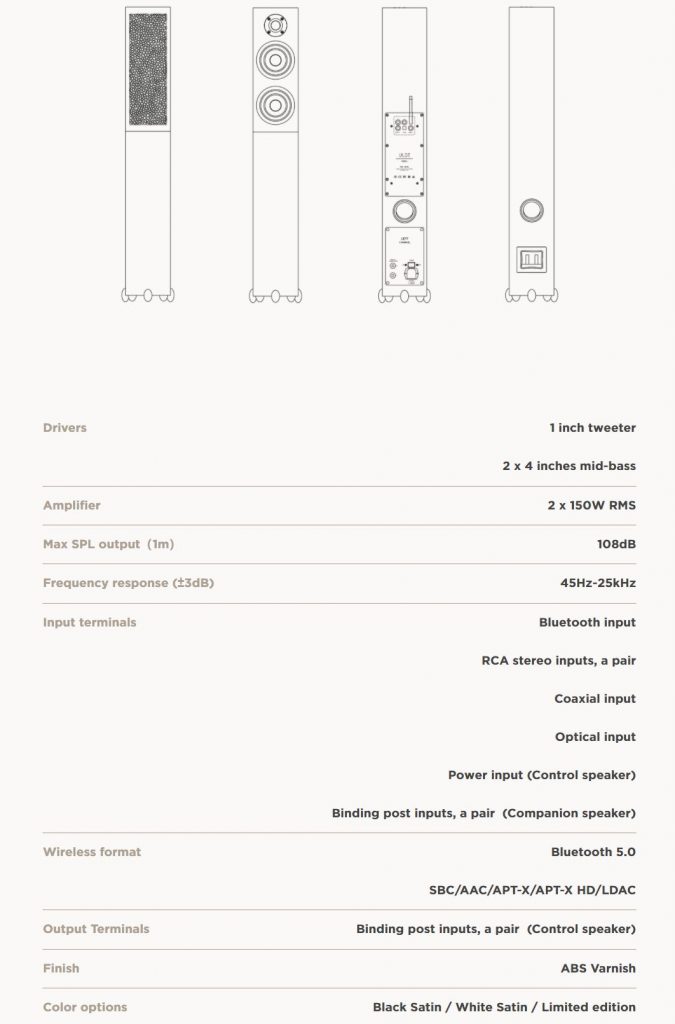
VLOT Spec from starkesound.com
One last impression I want to share in trying to convey the uniquely accurate live performance like presentation I hear from VLOT is this: For either my first time in a long time, or perhaps my first time ever, I witnessed what I will call distinct air between layers in the topographic wall of sound delivered. While "air" in sound quality parlance is something of an existential metaphor, it is also very real to me and to so many others. My first experiences with listening to natural recordings with air came from my introduction to DSD in the late 90s and early 2000. These were conversions of Sony archive analog tape masters to the genesis of the Sonoma DSD workstation prototype.
Air for me exists just as it implies, in the air space surrounding and usually above and between the more articulate sounds delivered through the speakers. Air, including breath, is especially palpable and real during playback of some of the legendary jazz and classical masters still used as SACD and DSD benchmarks. Seeking air as a natural ambient artifact of single take studio performances was something I became embroiled in attempting with my own original recordings beginning in those years and to this day using varieties of media and codec formats. Suffice to say I've worked for a few decades at improving my hearing of air.
What VLOT shows my ears is a bit of a detour from air as I have come to know it prior. Instead of being a superset of the sonic fabric detailing more natural attacks and decays of notes and percussive sounds played as demonstrated time and again through well made analog and digital recordings, VLOT somehow inserts a layer of what I'll also call air horizontally between different frequency bands/instruments and textures in the sound contained within my (now overstated) rectangular perimeter.
In Hawaii I've been told there may be something like 81 layers of air at any given moment, all moving in different directions and at different speeds separated vertically by altitude. That is a perfect metaphor for the type of layering I witness in VLOT, striking me with its decisive and well blended tonal balances and interplay. I am curious how the engineering design and components used in VLOT adhere to any of what my ears experienced as I try to describe here.
Summary
By chance, in my approach to auditioning these wireless or wired amplified speakers, I discovered that the VLOT setup (MSRP $1299 (black or white ABS varnish finish) / $1499 (limited edition ebony ABS varnish finish) adapts very well to an outdoor porch or lanai open space, with its no-fuss setup, and also quickly serves as a simplified approach to an indoor full frequency entertainment system. VLOT provides a low power consumption, high output delivery fabric of sound to any variety of small to mid sized spaces indoors or outdoors (covered lanai/patio) and are very easy to relocate as needed as a fully integrated wireless or wired audio system.

Full Moon Setting on Mauna Loa, Big Island, Hawaii – Photo by David Elias, © 2017
ERRATA – Notes to include somewhere above
- VLOT presented my ears with this unusual distinction I'll call a mid punch. Historically I'm no fan of mid range. As a rule 3-way speakers worry me when often the largest weight of their delivery is somewhere in the mid range. I then become very unbelieving in the authenticity of the performance I'm hearing. Having said all that, VLOT has a characteristic midrange punch that fits the surrounding highs and lows and draws me further in towards the performance. I had to set aside some midrange prejudices to realize this.
A similar note I made when listening was that with eyes closed it seems that anyone would identify VLOT as a 3-way system. Starke's approach here is that there are two identical 4" drivers referred to in the docs as "Mid-Bass" with assumed different crossovers. No obvious woofer to speak of. Yet the playback descends down to a solid 45 Hz in the right place at the right time. - Examination of Coax, Balanced Cables to RCA, Toslink inputs all TBD—Beginning and ending my evaluation of VLOT with MP3-320 via Bluetooth gave the specs in my head a worst case scenario. I can and will play a lot of other music through these adept amplified speakers beginning with a balanced XLR out from the iFi Pro iDSD WiFi enabled DAC/Preamp supporting DSD512 and below as well as full MQA decoding. Cabling Pro iDSD to VLOT should prove to be a further push in the full spectrum capabilities of these speakers.
- Out of the packaged box both VLOT speaker columns had problems with a hard rubber foot that was supposed to be firmly attached. One speaker had one of the 2 rubber foot pieces per speaker missing entirely and I ended up finding it in the stuff sack. I only noticed this was missing because the other speaker had a loose footing sticking halfway out. Curiously the insert hole in the cabinet appears to be threaded (I haven't examined closely but thought I felt threads there) yet the peg portion of the rubber foot is of course not threaded so I fitted them both appropriately as best I could with firm turns until seated. This took at least 2 of the 8 minutes I timed above.
- Considering the design requirement for the Left VLOT speaker to be close to an AC source (outlet, power strip) I can imagine an added convenient toggle switch on the back of the cabinet that would reverse left and right channels. This is not usually simple or possible on the client side when playing a Smartphone via Bluetooth or perhaps when an output delivery is anything but Left/Right RCA (i.e., Toslink or Coax). So in 3 out of 4 input scenarios, a L/R channel swap might be very handy.
- With the temperatures and humidity in Hawaii I appreciated the solid acrylic material used for the VLOT cabinets. The grille facing was also aesthetically and perhaps acoustically pleasant. Wood and fabric or any organic material in Hawaii, not unlike much of the warming planet, is subject to mold, warpage, discoloration and deterioration based strictly on weather trends and vog (volcanic smog consisting of sulfur dioxide and other particulate matter) not to mention salt air for much of the islands. VLOT appears to be better protected than most electronic products including solid seals against intrusive agents violating the circuitry itself. The ebony wood grained effect is well done and stylish here in a land of koa, mango and other exotic woods. All in all, well protected and well presented.
- No Remote – this would be useful for volume control outside of Bluetooth input sources where the only control is through the inset control panel on the left speaker.
- No WiFi – I am a long standing believer and proponent for moving past Bluetooth which did not need to become a world standard that has a range of merely 30 feet or less especially if a wall is involved. No matter how many revs of Bluetooth come out there were and are compatibility issues with the sender (player) and receiver (speaker). So lossless Bluetooth is a somewhat mysteriously achieved goal that can be difficult to prove or disprove in any listening session. As a superior and readily created alternative, lossless WiFi provides the needed bandwidth for codecs with no signal compression or loss that stays well connected within the LAN perimeter already provided by a router or mesh network. What oh what is this thing with Bluetooth loyalty? My iPhone is happy to and does connect over Airplay or UPnP anytime it can. Androids are in the same WiFi camp with Google Play. WiFi transmission on VLOT would require the appropriate vendor app as well.
- If you are looking for this class of speaker without the amplifier and DAC capabilities, it appears the V42 product at Starke is the same speaker spec, listed on their website at $998/pr.
VLOT Loudspeakers
Retail: $1299 (black or white ABS varnish finish) / $1499 (limited edition ebony ABS varnish finish)
Starke Sound
David Elias, February 2021
https://davidelias.com
https://davidelias.com/contact (contact)
https://youtube.com/davideliasvideo (artist YouTube channel)
https://art-of-listening.com (artist hi-res, surround blog)




